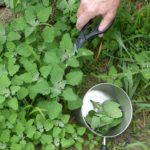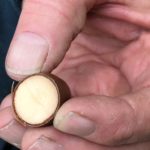by Winding Pathways | Sep 7, 2023 | (Sub)Urban Homesteading, Chickens, Garden/Yard
What’s Egg Color Got to Do With It?
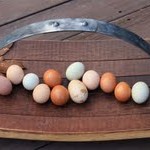
An array of jewels. Photo by Lisa Ramlo.
Are brown-shelled eggs better than white-shelled ones? Supermarkets sell all sorts of eggs. Brown or white shell. Free range or not. Organic. Vegan. Prices per dozen vary greatly. How is a consumer supposed to buy the freshest and tastiest egg?
We’ve been raising chickens for decades and have kept hens that lay white, brown, and even blue and green-shelled eggs. All are laid by birds of the very same species. The nutritional value of an egg is the same no matter what its shell color. Taste varies depending on how fresh the egg is and what the hen ate. It is independent of shell color.
Brown Eggs: Most supermarket brown eggs are laid by hybrid hens, often called ISA Browns. These were developed from the somewhat large Rhode Island Red breed. They may be raised in cages in enormous factory farms or come from a smaller free-range flock. Brown-shelled eggs may be free-range or organic……or not.
White Eggs: Almost all supermarket white eggs are laid by White Leghorn hybrids. They are smaller-bodied hens than brown egg layers and are commonly raised in cages in enormous chicken factory farms.
Blue or Green Eggs: Rarely seen in supermarkets, these beautiful eggs are laid by the Araucana breed or hybrids developed from them. These hens are common in backyard flocks.
Organic: If labeled organic the hens are supposed to have been fed feed raised according to organic standards. Eggs marked vegan or natural may or may not be organic. Be wary of vegan eggs, as hens are omnivores. If they encounter insects, worms or meat scraps they’ll readily devour them.
Cage Free: The hens that laid these eggs normally are crammed into a large building but are not confined to the tight space of a cage. They may, or may not, have access to the outdoors.
Free Range: This is tricky. Supposedly free-range hens have ready access to the outdoors, but there may be only a tiny outdoor run for thousands of hens to enjoy.
How To Tell If Eggs Are Fresh

Store-bought eggs are a pale yellow with runny whites. Fresh eggs radiate a golden hue centered in a firm albumen.
Nearly all egg cartons claim that the eggs inside are fresh, but what does that mean? They could have been laid six weeks earlier. To tell if an egg is fresh, fill a deep bowl with water and gently put an egg on the surface. If it sinks it’s reasonably fresh. If it floats it’s old. The reason is, a fresh egg has a small air cell. As it ages, moisture leaves through the porous shell and the air cell grows, making the egg buoyant.
The white, or albumen, of a fresh egg, will be relatively deep when cracked into the frying pan. It will spread out widely and be flat in an old egg.
How to Tell if Hens are Truly Pastured Raised
Most commercial eggs come from hens fed a specially prepared diet that provides all the nutrients they need but little else. The eggs will have pale yolks. In contrast eggs laid by hens with ready access to green vegetation will lay eggs with deep orange or yellow yolks. Some premium chicken feeds include marigold petals that impart deep color to the yolks.
Choosing the Highest Quality Eggs
It may take buying several dozen differently marketed eggs to find the freshest, tastiest, and most attractive eggs. Although the least expensive eggs usually come from factory farms, the best eggs aren’t always the most expensive. The very best will be fresh and have a boldly colored yolk.
For information on chicken breeds scan the Hoover’s Hatchery Website . For general information on eggs and recipes check out the website of the Egg Industry Center.
by Winding Pathways | Nov 3, 2022 | (Sub)Urban Homesteading, Chickens
Well, our Ninja Hen is at it again. A neighbor, watching the hens for us, entered the barn one morning to find the California White strutting around inside the barn but out of the coop! Looking around, our neighbor also found a small white egg in a depression in the sand in a tucked-away corner of the barn.
After some coaxing, Ninja Chicken hopped back into the coop through the door our neighbor had opened.
Reinforcing Didn’t Work
You may remember an earlier blog where we explained that Rich had blocked off all the areas he could see where she might be able to fly up to and escape into the barn. All was well for several weeks.
Meanwhile, Houdini Hen (aka Ninja Chicken) was figuring out how to “fly the coop” so to speak.
And she did. One morning, we too, found her again proudly prancing around the barn. She looked at us and seemed to say, “Haha. You can’t keep me in!” But, she could not quite figure out how to get back into the coop.
How in the world did she escape?
We looked around and found over in a far corner another gap between the chicken wire and the ceiling. The wire was bent down so we speculate that she worked at bending it when she landed on the wire and eventually had enough space to squeeze through and roam the barn at will laying eggs in that cozy little corner. The wire is straightened and the space is now plugged with plywood. Will she figure out another way to escape? We’ll know in the next few days.
Lesson

Our Ninja Chicken
This hen continues to teach us something. Chickens are not dumb clucks. This girl used intelligence to find an exit and demonstrated amazing athletic ability getting to and through a relatively small hole up high near the ceiling. And she is first in line for snacks, too.
by Winding Pathways | Oct 20, 2022 | (Sub)Urban Homesteading, Chickens, Garden/Yard
One of our 14 chickens is a true American Ninja Chicken. Most of us know the TV program American Ninja Warriors where athletes navigate extreme obstacles to beat the buzzer. Well, this gal, a California White, is right up there with the most athletic of them all.
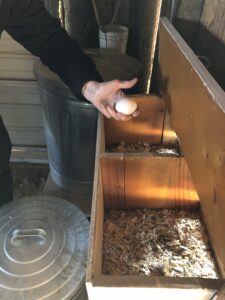
Our American Ninja Warrior Chicken begin to lay eggs at about 20 weeks.
Like most hens, when she reached about 20 weeks old, she laid her first egg in our coop. Then another a couple of days later. Then, none. And, none the next day. That’s unusual. When a hen starts laying, she’ll usually continue.
One evening, Rich counted the hens. There were 13. Hmmmm. Where’s the 14th? Had she met her fate? After recounting three times, checking the run, and scratching his head over this mystery, came a cluck from the attic of the barn. Could she have made the tortuous way up through the rafters into the barn’s attic? Naw. No chicken could do that. Then we remembered that another California White hen had laid eggs in the barn attic. So, Rich got the stepladder and checked anyway.
There she was up in the barn attic above the coop our second American Ninja Chicken proudly looking at her freshly laid egg.
Are Ninja Chickens Dumb Clucks? Not Really
A chicken myth is that they are dumb. Everyone “knows” that. Nope. Not true. To get into the attic our hen had to be both smart and athletic. Brains figured out a pathway through rafters, plywood, spools of wire, and stored items. Athleticism got her there. She negotiated an obstacle course like what we watch on TV’s American Ninja Warrior.
Once she reached the barn attic, she found the darkness and privacy hens appreciate when nesting. Unlike human ninjas,
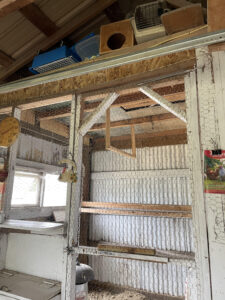
The American Ninja Warrior Chicken wormed her way to the barn attic.
there wasn’t a buzzer to ring when she got up there, but her clucks gave away her presence.
We admire her athleticism and smarts, but laying eggs up there won’t work. We need to easily collect them. So, we spent a morning plugging up any possible route to the attic.
We may have succeeded. Today’s egg was in the coop, but we’re certain she’s trying to figure out how to again reach the attic. She might outwit us.
When do Chickens Start Laying Eggs?
Female baby chicks usually start laying when they are 16 to 24 weeks old. Of the many breeds of chickens those that lay white eggs are relatively small, agile, and intelligent. They can worm their way into inaccessible places and fly like a pheasant. In contrast, most brown egg layers are heavy and cumbersome, and struggle just trying to get airborne.
Our American Ninja hen is a California White, a Leghorn hybrid. She’s small, fast, agile, and determined and lays white eggs – in the attic of the barn.
by Winding Pathways | Jul 7, 2022 | (Sub)Urban Homesteading, Chickens, Garden/Yard, Nature, Weeds
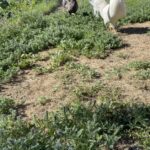
Chickens in run
A chicken run is one tough place for plants to live, and our run at Winding Pathways is even tougher than most.
Every day we let our chickens roam around the run. A bright baking sun broils the sandy soil all day long, so it’s hard to imagine that any plant can thrive there. And, chicken run plants face another challenge. The birds love greenery and usually devour every plant they find. As a result, most chicken runs are just bare dirt that’s either dusty or muddy.

Flower and leaf
Big Bracht Verbena (Verbena bracteata), sometimes called Prostrate Vervain, is up to the challenge. It carpets our chicken run. We didn’t plant it. Verbena moved in on its own. Hopefully, our chickens enjoy viewing the plants’ tiny soft blue flowers.
Big Bracht Verbena is common across much of North America, but it’s easy to overlook. Rarely causing problems, it lives in the most difficult environments. The plant thrives in hot dry gravel soil along roads, in vacant lots, and in sidewalk cracks.
We like having this humble plant in our chicken run. It covers the soil, eliminating mud that follows rain. Chickens absolutely won’t eat it, but they love snatching the insects lured to the plant. It needs no human care, but we sometimes mow it if it gets a big shaggy by late summer.
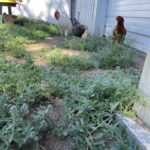
Foraging among verbena
One of nature’s mysteries is how plants have adapted to thrive in all sorts of environments, even harsh ones. Hats off to Big Bracht Verbena.
by Marion Patterson | Jun 2, 2022 | Chickens, Garden/Yard, Geology/Weather, Hoover's Hatchery, Preparedness, Reflections/Profiles, Travel/Columns
Coming up to a year from the last post on the features we wrote for the Cedar Rapids Gazette, here is an updated list for the second half of 2021 and the first half (almost) of 2022. These features are in addition to our regular work with Hoover’s Hatchery blogs and FB Live and our own blogs for Winding Pathways.
May 8, 2022. Splish Splash! Whitewater Kayaking in Iowa. (No link to date)
April 22, 2022. Finding America On Roadways East.
April 13, 2022. Muscle Over motor When Boating.
March 21, 2022. Rockhounding.
January 30, 2022. Backpacking Bonus. (8B of GZ. No link to date) Available Green Gazette.
January 24, 2022. Distinctive Religious Structures.
January 16, 2022. Hiking Wild Areas. (no link to date) Available Green Gazette.
December, 2021. Country Schools. (no link to date) Available Green Gazette
November 15, 2021. Making a (Mini) Pitch for Soccer.
October 6, 2021. A visit with Midwest’s Pioneering Authors.
September 8, 2021. Taking a Slow Boat to Cassville.
September 6, 2021. Camping in Iowa’s Trout Country & Decorah’s Celebrities.
August 4, 2021. Parking While Headed East. And Solar Panels at Peoples.
by Winding Pathways | Apr 28, 2022 | (Sub)Urban Homesteading, Chickens, Foraging, Garden/Yard, Garden/Yard, Weeds
We are shocked by the rise of many prices, especially food. Fortunately, we mute the cost by finding or growing groceries here at Winding Pathways. We’re lucky to own two acres, but folks living on tiny lots can produce an amazing amount of food, even if they aren’t passionate gardeners.
In a nutshell here’s what we do to tame grocery bills:
Foraging
It’s ironic that many people consider the most delicious and easy wild foods pests and spend time and money trying to eliminate them. We eat ‘em. Books and websites, including Winding Pathways, share tips on finding, identifying, harvesting, cooking, and eating wild foods. Caveat: ALWAYS check that you have the correct plant, gather from unpolluted places, and consume only a small amount initially to be sure your body accepts the wild edible.
Here are our favorites:
Gardening
We’re not passionate gardeners and we don’t can or freeze vegetables, so here’s what we do:
- Succession plant: Our small garden yields an enormous amount of food. We don’t let a square foot be idle. When summer’s heat turns lettuce bitter, we pull it, feed it to our chickens, and plant beans or another heat-loving crop. Same with other crops that grow quickly and then fade.
- Use vertical space: Pole beans, for example, produce much more food per square foot than bush beans, so we choose climbers and use vertical space. We have the pole high enough to reach up and pull off the beans.
- Grow dwarfs: Some cucumber varieties, for example, are “bush” type, meaning they produce a crop without long vines that consume plenty of space.
- Think of winter eating: Because we lack freezer space and don’t can food, we plant vegetables that need little care during the growing season and store them until late winter without being canned or frozen. Here’s our list:
-
- Winter squash. Pick them, let them curet, and store them in a cool spot. They keep for months. Same with pie pumpkins.
- Carrots and parsnips. In late fall we smother the plants with a thick blanket of dry leaves or straw that keeps the ground from freezing. We’ve harvested carrots in January by brushing away snow and peeling back the mulch and pulling them.
- Sweet potatoes. They love the South’s climate yet grow well up north.
We carefully dig them in the fall, cure them, and store them like winter squash.
-

-
Sweet potatoes are a healthy vegetable.
-
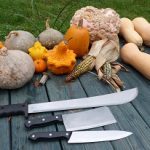
-
Winter Squash vary in color, texture, shape and size.
Chickens
We can’t imagine living without a small chicken flock. Our six to 12 hens gift us a couple of dozen eggs a week. Their manure fertilizes the garden and garden weeds are a great hen chow. During warm months our hens forage in their large run eating bugs, worms, and weeds and transforming them into eggs. Sometimes we even stew down an old hen.
-
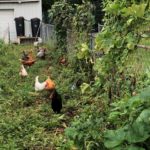
-
In the summer hens find plenty to eat.
-
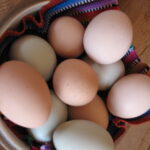
-
The chickens kept on laying eggs.
-

-
Chickens efficiently recycle squash seeds to eggs.
Wildlife
Lots of folks don’t like hunting. For us harvesting a deer is a form of food gathering, not recreation. After all, deer are free-ranging, local, and organic. Fortunately, we’re able to hunt on our property and convert a deer into delicious meat. We also enjoy eating panfish.
Like most folks, we can’t grow or forage all our food but much comes from the yard and area. It takes knowledge and investment in elbow grease but trims the food budget. Perhaps even better, knowing how to find and grow food makes us feel less vulnerable to national disruptions that make food either hard to get or expensive.










